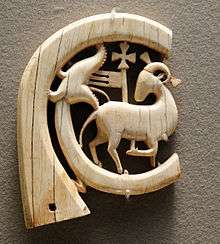Agnus Dei (music)
Agnus Dei, referring to the Christian theological concept of the Lamb of God, and the associated liturgical text from the Roman Catholic Latin Mass has been set to music by many composers, as it is normally one of the movements or sections in a sung Mass setting.[1][2] However, sometimes it stands alone, e.g., it provides the lyrics for Agnus Dei, the choral arrangement of Samuel Barber's Adagio for Strings.
Text
The Agnus Dei is a setting of the "Lamb of God" litany, based on John the Baptist's reference in John 1:29 to Jesus ("Behold the Lamb of God that taketh away the sin of the world"):
- Agnus Dei, qui tollis peccata mundi,
- Lamb of God, who takes away the sins of the world,
- miserere nobis.
- have mercy upon us.
- Agnus Dei, qui tollis peccata mundi,
- Lamb of God, who takes away the sins of the world,
- miserere nobis.
- have mercy upon us.
- Agnus Dei, qui tollis peccata mundi,
- Lamb of God, who takes away the sins of the world,
- dona nobis pacem.
- grant us peace.
In a Requiem Mass, the words "miserere nobis" are replaced by "dona eis requiem" (grant them rest), while "dona nobis pacem" is replaced by "dona eis requiem sempiternam" (grant them eternal rest).
Examples
Some examples from full mass settings include:
- The fifth movement of Guillaume de Machaut's Notre Dame Mass
- The twenty-fourth movement of Johann Sebastian Bach's Mass in B minor
- The seventh part of Wolfgang Amadeus Mozart's Requiem
- The tenth part of Ludwig van Beethoven's Missa Solemnis
- The sixth movement of Franz Schubert's Mass No. 2
- The sixth movement of Robert Schumann's Mass in C Minor, Op. 147
- The fifth movement of Gabriel Fauré's Requiem
- Movement 5 of John Rutter's Requiem
- The fifth movement of Bob Chilcott's Little Jazz Mass
- The fifth movement of Ralph Vaughan Williams' Mass in G minor (Vaughan Williams)
- The fifth movement of Benjamin Britten's War Requiem, in which the text is interleaved with Wilfred Owen's poem "At a Calvary near the Ancre"
Further examples are too numerous to name, as virtually every setting of the Mass Ordinary or Proper (of which there are thousands) includes an Agnus Dei. The text has also been used by composers for arrangements in popular culture, including:
- Elliot Goldenthal for Alien 3
- Keiki Kobayashi for Ace Combat 04: Shattered Skies
- Elitsa Alexandrova for Assassin's Creed Rogue
- Enya for the song 'mTrains and Winter Rains
- Halsey for the song Castle
- Kuroshitsuji (Black Butler) soundtrack for episodes 17 and 18
